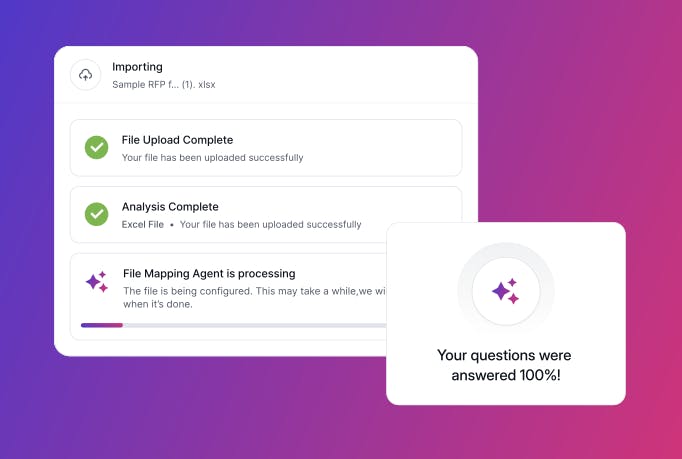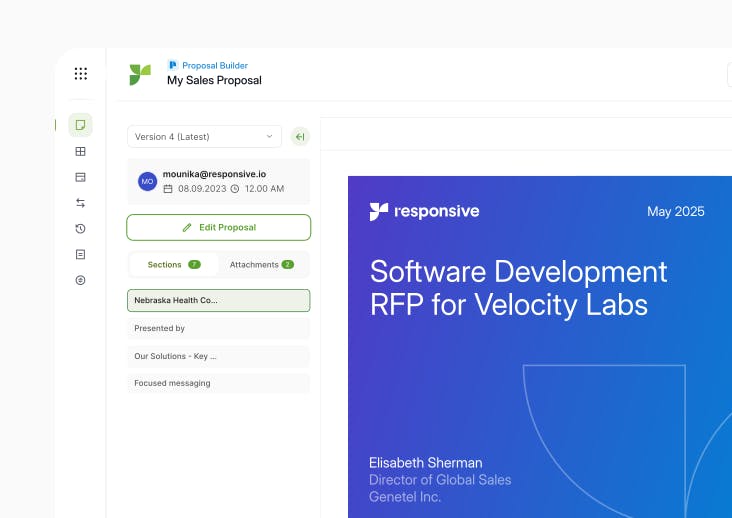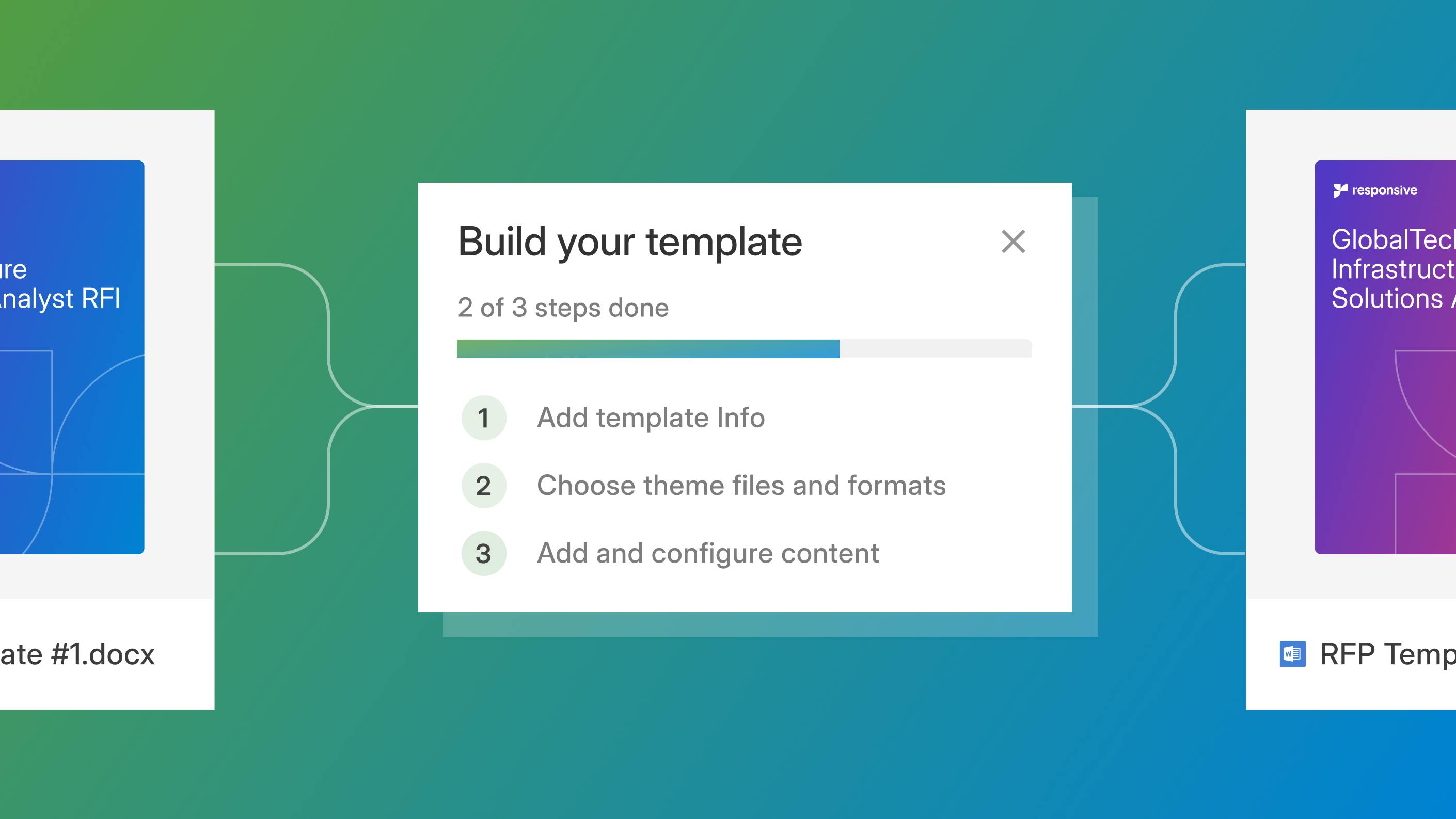In today’s fast-paced sales landscape, creating standout proposals is no longer a nice-to-have — it’s a necessity. Buyers expect personalized, accurate, and timely responses. Meanwhile, bid and proposal teams are juggling multiple deadlines, managing siloed content, and racing against abbreviated turnaround times.
According to Responsive’s 2024 State of Strategic Response Management (SRM) Report:
- 77% of bid and proposal professionals report heavier workloads compared to a year ago.
- Over 70% of companies attribute year-over-year revenue growth to RFPs, bids, tenders, and proposals.
To rise above these challenges, many organizations are turning to proposal automation software to accelerate sales cycles and build trust quickly. Proposal automation is the use of AI-driven technology and workflow tools to streamline and accelerate the process of creating business proposals. It replaces manual, repetitive tasks — such as content assembly, formatting, task management, and review coordination — with intelligent automation.
By leveraging centralized content libraries, automated assignments, real-time collaboration, and AI-generated responses, proposal automation enables teams to produce accurate, consistent, and personalized proposals at scale. The result is faster turnaround times, improved quality, and a more efficient path to winning business.
So, what exactly can you expect once you implement proposal automation? Let’s explore the benefits, capabilities, and real-world impact of modern proposal automation software.
Why proposal teams are adopting automation software

Proposal teams face rising RFx volumes, tighter deadlines, and growing competition. As proposals become more complex and resource-intensive, teams fall behind if they have to rely on manual processes. Proposal automation software offers a fast, reliable way to manage workflows, maintain consistency, and hit deadlines without sacrificing quality.
AI-powered tools streamline proposal creation by breaking down complex RFPs into clear, actionable tasks. Centralized content libraries keep information accurate and accessible, making it easier to reuse approved responses — as-is or as resources for sophisticated generative AI that can craft personalized responses on the spot. Automation also assigns tasks to the right SMEs, tracks progress, and ensures compliance.
These tools save teams time on repetitive work that they can instead spend on strategic, high-value contributions — driving better collaboration, stronger proposals, and improved win rates. They transform proposal management from a bottlenecked administrative function into a competitive advantage with widespread revenue impact.
Signs that you might need better proposal tech
When is it time to upgrade your tech stack with proposal automation software? If your revenue teams are struggling to keep up, deliver consistent quality, or collaborate effectively, outdated tools and manual processes may be holding them back. Here are some common indicators that it’s time to consider better proposal technology.
- Overwhelming RFP volume: If your proposal team is constantly racing to meet deadlines and your sales team is turning down opportunities due to bandwidth, your current process likely cannot scale with demand.
- Lack of a structured content repository: When content lives across scattered folders, inboxes, and spreadsheets, finding accurate, up-to-date responses becomes time-consuming and error-prone.
- Not yet leveraging AI: Companies with revenue growth are 3X more likely to use proposal automation technology that uses AI.
- Disjointed workflow: Without a clear, repeatable process, tasks fall through the cracks, deadlines slip, and accountability becomes murky.
- Ineffective cross-functional collaboration: If sales, SMEs, and proposal teams aren’t aligned it leads to delays, miscommunication, and proposals that miss the mark.
- Inconsistent deliverables: Proposals that vary in tone, format, and quality can undermine your brand’s credibility and confuse buyers.
- Declining win rate: Drops in win or down-select rates may signal that proposals don’t stand out and aren’t reaching the finish line polished and on time; it could also mean that you’re not pursuing the right opportunities..
- Frustrated proposal managers and subject matter experts: Burnout and disengagement are red flags that your teams spend too much time on manual, repetitive tasks instead of strategic work.
What to expect: key outcomes of proposal automation

Faster turnaround times
Proposal automation speeds up turnaround times by eliminating manual tasks, enabling real-time collaboration, and surfacing pre-approved content. Teams can generate first drafts instantly, route tasks automatically, and access a centralized knowledge base — cutting down rework and delays. Integrated tools keep workflows moving without context switching, while built-in analytics provide visibility into bottlenecks.
Improved efficiency and collaboration
You can automate multiple facets of the proposal process to boost efficiency with the right software, including streamlining repetitive tasks, auto-filling answers, and organizing content in a centralized library. You can enhance collaboration through real-time editing, automated workflows, and built-in communication tools like @mentions and task assignments.
Teams stay aligned, work faster, and reduce rework — delivering consistent, high-quality proposals with less effort.
Stronger content governance
Proposals and responses to external information requests are only as good as the content used to inform them. Outdated, inaccurate, or non-compliant content puts proposals and relationships at risk.
Proposal automation software strengthens content governance by centralizing approved answers, templates, and brand messaging in one accessible library. Version control, expiration dates, and review workflows ensure content stays accurate, compliant, and up to date. Role-based permissions prevent unauthorized edits, while audit trails track changes for accountability. Automated alerts prompt regular reviews, so nothing goes stale. This control helps teams maintain consistency, reduce risk, and respond with confidence.
Improved win rates
Proposal automation software improves win rates by enabling faster, more accurate responses to RFPs, bids, and tenders. You can quickly tailor proposals using pre-approved content, reducing errors and ensuring consistency. AI-driven insights help craft stronger narratives and highlight differentiators, increasing the chances of making it to the down-select phase. It also supports more effective go/no-go decision-making so that your teams are only working on the opportunities they’re most likely to win.
Consistent quality
With a centralized library of approved and up-to-date content — enhanced by AI-led governance workflows — every proposal automation software user in your organization can deliver confident responses at scale. Instead of rewriting responses each time, you draw from templates and Q&A pairs that reflect your brand voice and expertise. Automated workflows ensure every response goes through the right reviews, so nothing gets missed. As your team handles more RFPs, bids, and tenders, automation keeps quality high — no matter how fast you move or how many projects you take on.
Centralizing the information around corporate content, technical and solution content, templates, branding — you name it — if you centralize that and open it up to the sales team, you’re ensuring that your entire company is showing up in the best way possible for customers.
Carrie Jordan
Global Director of Proposals at Microsoft
Satisfied users
Proposal automation software boosts your team’s morale by eliminating repetitive, manual work — like chasing down answers or formatting documents. With less stress and fewer fire drills, your team gains the freedom to focus on more strategic, rewarding tasks like crafting win themes or refining messaging. Automation reduces burnout, speeds up collaboration, and reduces the need to constantly interrupt SMEs with repetitive requests to answer the same questions in proposals and questionnaires.
What to expect: must-have features for proposal automation software
AI-powered functionality
In proposal automation, AI auto-generates high-quality first drafts, recommends the best answers based on past wins, and tailors content to match tone and context. You save hours per proposal while improving accuracy and consistency. AI also surfaces insights to help you qualify opportunities, prioritize tasks, and optimize responses — so you can focus on strategy, not busywork.
See how JAGGAER used AI to reduce time spent maintaining their content library by 50%.
Robust integrations
How a new software platform blends in with the rest of your tech stack can make all the difference when it comes to rapid ROI and fast adoption. Robust integrations let you work where you’re already comfortable — like Slack, Microsoft Office, or your CRM — without jumping between tools. With everything connected, you can pull content, track progress, and collaborate in real time, all within your existing workflows. This reduces friction, boosts productivity, and ensures your proposal process runs smoothly from intake to submission.
See how Seismic improved user satisfaction in the proposal process with a Salesforce integration and their own integration with Responsive.
Advanced content management
Advanced content management gives you control and confidence in every response. With AI-powered deduplication, you eliminate outdated or repetitive content, keeping your library clean and easy to search. Automated workflows prompt SME reviews, so answers stay accurate and aligned with the latest messaging. You save time, reduce risk, and ensure your team always responds with high-quality, up-to-date content.
See how Stibo Systems leaned on Responsive Professional Services to establish content management best practices and save 20-60 hours per project.
Enterprise-grade security and compliance
Enterprise-grade security and compliance give you peace of mind as you scale. With secure AI that doesn’t train on your data and built-in safeguards, you can respond to RFPs, bids, and tenders globally without worrying about data leaks or compliance gaps. Role-based access, audit trails, and encryption keep sensitive content protected, while maintaining control over who sees what. You move faster — without increasing your organization’s risk exposure.
See why the security and privacy of Responsive AI was a “slam dunk” at Netsmart.
What to expect: beyond features
Onboarding/Training
Look for onboarding and training that includes hands-on support, role-specific guidance, and access to on-demand resources. Professional services should help you align the software to your workflows, speed up adoption, and set your team up for lasting success.
Scalable functionality
Choose software that scales with your team — think user management, workflow automation, and content governance. Look for AI features, robust integrations, and analytics that grow with you. Scalable functionality ensures you handle more RFPs without added strain, increasing your efficiency and impact on revenue growth.
Customer support
Live help, self-service resources, and a dedicated success team are table stakes. Ask for references or testimonials specific to customer support. And check G2. Choose a vendor that offers professional services to help set up your knowledge base and guide you on best practices — so you get the most out of the software from the start.
Pricing and ROI
Look for transparent, scalable pricing that fits your team size and project volume. To calculate ROI, track metrics like response time reduction, proposal win rates, SME hours saved, and revenue influenced. The right software should pay for itself by helping you win more, faster — with less effort.
Exceed industry standards with Responsive proposal automation
With Responsive, you don’t just automate proposals — you transform how your team wins work. The Responsive Strategic Response Management Platform helps you scale effortlessly, respond faster, and raise the bar on proposal quality. At the heart of this transformation are Responsive AI agents — specialized, intelligent companions that handle mission-critical tasks across the proposal lifecycle.
These agents autonomously analyze complex RFPs, structure documents, and generate winning responses pulled directly from your trusted content library. Working seamlessly within tools like Slack, Teams, and Word, they eliminate manual effort, accelerate decision-making, and ensure accuracy. Paired with real-time collaboration and automated workflows, Responsive empowers your team to deliver standout proposals — consistently, confidently, and at scale.
